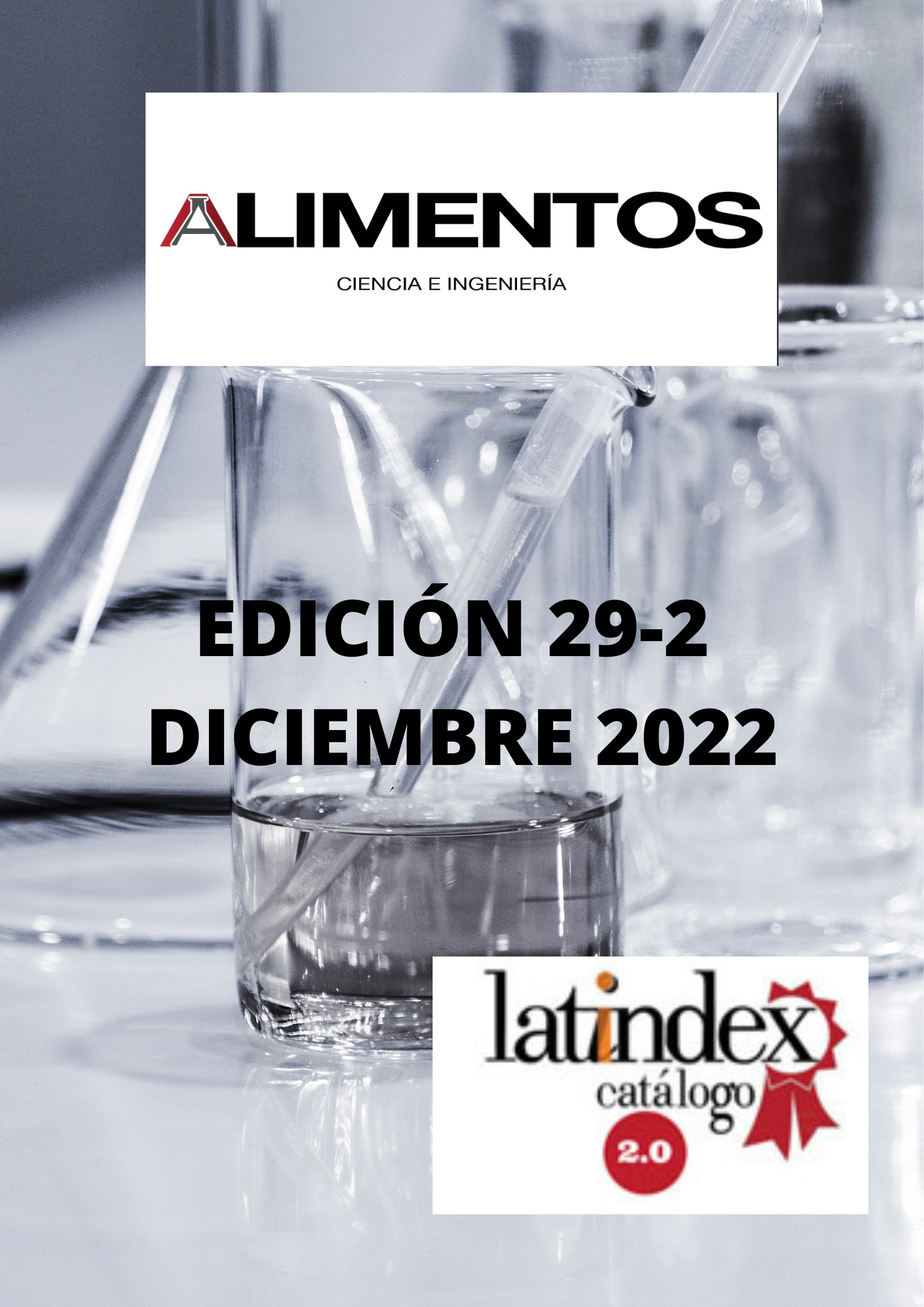Growth Kinetics of Aspergillus niger IN Solanum tuberosum
Main Article Content
Abstract
In this research, the growth kinetics of the fungus Aspergillus niger in Solanum tuberosum were studied. Microbial fermentation was carried out in a medium formulated with organic residues of Solanum tuberosum with a humidity of 61%. Samples were taken every other day to estimate cell growth by the dry weight method. The kinetic parameters of the microorganism were determined obtaining a specific growth rate of 0.016 h-1 using a linear model. The Gompertz, Logistic, Brody and Bertalanffy models were evaluated, of which Bertalanffy and Brody were the best fit for the data, with a coefficient of determination (R2) of 0.994 in both models.
Downloads
Article Details

This work is licensed under a Creative Commons Attribution-NonCommercial 4.0 International License.
Aquellos autores/as que tengan publicaciones con esta revista, aceptan los términos siguientes:
a. Los autores/as conservarán sus derechos de copiar y redistribuir el material, bajo los términos estipulados en la Licencia de reconocimiento, no comercial que permite a terceros compartir la obra bajo las siguientes condiciones:
Atribución: debe dar el crédito apropiado, proporcionar un enlace a la licencia e indicar si se realizaron cambios. Puede hacerlo de cualquier manera razonable, pero no de ninguna manera que sugiera que el licenciante lo respalda a usted o su uso.
No comercial: no puede utilizar el material con fines comerciales.
Sin restricciones adicionales: no puede aplicar términos legales ni medidas tecnológicas que restrinjan legalmente a otros hacer cualquier cosa que la licencia permita.
References
Apunte, D., Fernández, D. y López, O., D. (2019). Obtención medio enriquecido en proteínas a partir de residuos de papa (Solanum tuberosum) por fermentación microbiana. Alimentos, Ciencia e Ingeniería, 27(1), 93–107.
Arguero Tayupanta, A. P. (2014). Estudio de la producción de enzima amilasa mediante Aspergillus niger por fermentación sólida, con el uso de residuos agroindustriales.
Calderón Vargas, J. F. (2017). Ajuste de un modelo cinético para el crecimiento de Lactobacillus acidophilus en la fermentación de un sustrato complejo.
Castro, G., Valbuena, E., Sánchez, E., Briñez, W., Vera, H. y Leal, M. (2008). Comparison of Sigmoid Models Applied to the Growth of Lactococcus lactis subsp. lactis: Vol. XVIII.
Chambi, D., y Torres, A. M. (2021). Modelos cinéticos sigmoidales aplicados al crecimiento de Saccharomyces boulardii. Revista de Investigaciones Altoandinas, 23(1), 47–54.
Colorado Hernández, S. (2018). Determinación de parámetros cinéticos de Synechococcus sp. pcc 7002 en cultivo sumergido. https://repository.eafit.edu.co/handle/10784/13698?locale-attribute=es#.YqIgDBOWdQM.mendeley
Cueva Calva, Y. M. (2017). Producción de amilasas mediante fermentación submersa de aspergillus niger para su empleo en procesos de panificación. https://repositorioslatinoamericanos.uchile.cl/handle/2250/2792412#.YqEm9fodWb8.mendeley
de Castro, A. M., Teixeira, M. M., Carvalho, D. F., Freire, D. M., & Castilho, L. (2011). Multiresponse Optimization of Inoculum Conditions for the Production of Amylases and Proteases by Aspergillus awamori in Solid-State Fermentation of Babassu Cake. Enzyme Research, 457392.
Ferrer Romero, J. C., Mas Diego, S. M., Beltrán Delgado, Y., Morris Quevedo, H. J., & Díaz Fernández, U. (2019). Kinetic study of the production of biomass and phenolic compounds for Pleurotus ostreatus in submerged phase. In Rev. Cubana Quím (Vol. 31, Issue 1). http://ojs.uo.edu.cu/index.php/cq
Gómez Reyes, R., Medina Moreno, S. A., Jiménez González, A., & Lizardi Jiménez, M. A. (2017). AISLAMIENTO Y ANÁLISIS CUALITATIVO DE BIOMASA MICROBIANA FÚNGICA DEGRADADORA DE HIDROCARBUROS DE UN CENOTE DE QUINTANA ROO. Especial Biotecnología e Ingeniería Ambiental, 53–61. https://doi.org/10.20937
Madigan, M. T., & Martinko, J. M. (2010). Brock Biology of Microorganisms. International Microbiology; Vol. 8, Núm. 2 (2005); 149-150.
Mendez Alvarez, J. A. (2013). PRODUCCION DE ACIDO GLUCONICO APLICANDO CINETICA DE CRECIMIENTO MICROBIANO A PARTIR DE Aspergillus niger Y COMO MEDIO DE CULTIVO, DULCE DE ATADO.
Nout, M. J. R. (2014). Food Technologies: Fermentation. Encyclopedia of Food Safety, 3, 168–177. https://doi.org/10.1016/B978-0-12-378612-8.00270-5
Pérez, G., Larrosa, E., & Escámez, F. (2016). Modelos matemáticos para la descripción del crecimiento de microorganismos patógenos en alimentos. In Anuario de Jóvenes Investigadores (Vol. 9).
Prescott, L. M., Harley, J. P., Klein, D. A., Carlos Gamazo de la Rasilla, T., York, N., Juan, S., Bogotá, S. de, & Paulo, S. (2002). Microbiología.
Torres Vargas, G. M. (2013). Cuantificación del contenido de proteína celular (SCP) en la biomasa de la levadura Saccharomyces cerevisiae producida a partir de residuos de cáscaras de naranja (Citrus sinensis l var valencia) y papa (Solanum tuberosum) variedad diacol capiro (R-12) para uso en la alimentación animal. Universidad Nacional Abierta y a Distancia. https://repository.unad.edu.co/handle/10596/1070?locale-attribute=fr#.YqEXGcVvLhI.mendeley
Villegas R., D. A., Valbuena, N., & Milla P., M. E. (2019). Evaluación de modelos aplicados a la producción de materia seca de Brachiaria brizantha en el periodo lluvioso. Revista de Ciencias Agrícolas, 36(1), 33–45. https://doi.org/10.22267/rcia.193601.96
Waglay, A., Achouri, A., Karboune, S., Zareifard, M. R., & L’Hocine, L. (2019). Pilot plant extraction of potato proteins and their structural and functional properties. LWT, 113, 108275. https://doi.org/10.1016/J.LWT.2019.108275
Zapata M, J. E., Hoyos R, M., & Quinchía B, L. A. (2005). PARÁMETROS CINÉTICOS DE CRECIMIENTO DE Saccharomyces cerevisiae EN PRESENCIA DE UN CAMPO MAGNÉTICO VARIABLE DE BAJA INTENSIDAD Y ALTA FRECUENCIA FREQUENCY. Vitae, Revista Sw La Facultad de Química Farmacéutica, 12(1), 39–44.


